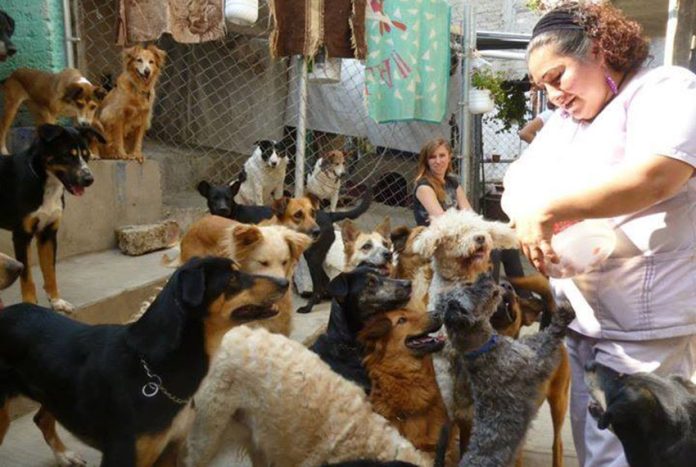Alarms started going off in the Mexican press as early as May 2020 noting the significant rise in cases of animal abuse, neglect and, in particular, abandonment as coronavirus isolation measures came into full force.
Dealing with the problem of unwanted animals, particularly dogs and cats, has never been easy in Mexico. For many, animals are a purely practical matter, not considered indispensable members of the family. If they are seen as a drain on resources, there is less hesitancy to get rid of them.
In addition, there are no nationwide organizations here dedicated to animal welfare such as the American Society for the Prevention of Cruelty to Animals. Many shelters are very local — even personal — projects that rely often on networks for donations.
The pandemic has strained families economically and emotionally. This has meant a triple whammy for shelters: fewer donations, fewer volunteers because of quarantine and more animals finding themselves out on the street or abused.
This crisis is not unique to Mexico, but the levels of abandonment have hit record levels.

According to the Animal Protection Agency in Mexico City, there are an estimated 140,000 dogs and 49,000 cats living on the streets of the capital alone. Animal abandonment has increased by 15% nationwide since January 2020, with eight out of 10 calls to shelters and animal control authorities reporting an abandoned animal.
There are several Covid-related reasons why animals have become homeless. The first and foremost is economic: incomes have dropped, especially for poorer families. The second is due to the fact that for a time in 2020, it was believed that people could contract the virus from household pets — something that has been countered by official statements from the World Health Organization and Mexican authorities.
In yet other cases, animals have been abandoned because an owner died of the coronavirus and family members do not want to take responsibility for the pet, says Mundo Patitas, a private animal shelter in Huehuetoca, México state.
The resources of animal shelters, already woefully inadequate before the pandemic, are now facing even further strain.
“The economic situation of shelters is critical,” says Maya Pindter, a rescuer in Mexico City.
Firstly, donations are down because people are experiencing financial difficulties. Meanwhile, Rosalva Francisco — who has rescued animals at a home and pottery workshop in the Mexico City borough of Tláhuac for almost two decades — reports that there have been increases in the costs of food and medicines. The lack of necessities, plus overcrowding, are stressing the animals lucky enough to be sheltered, never mind those still on the street.

There have been some efforts to address the situation: in April 2021, the Animal Attention Agency (Agatan) of Mexico City’s Environment Ministry (Sedema) partnered with the Mars México company’s Pedigree Adóptame program to deliver 69 tonnes of animal food to shelters, but it is nowhere near enough.
Shelters also lack manpower, losing volunteers as people are concerned about contact with animals and other humans. The National Network for Assistance to Animal Shelters has had to cut back on visits and other social interaction with the shelters they support in Mexico City, México state, Chiapas, Querétaro and Puebla.
Francisco says that municipalities have also cut back on their programs for free or low-cost pet sterilizations and rabies vaccinations, leading to more puppies and kittens and more problems with rabies.
The trap-neuter-release strategy has never been a popular way to deal with feral cat and dog populations in Mexico, and the few organizations that do this sort of work are private, such as Escuchemos el Eco de su Voz in San Miguel de Allende. Jessica Carreon, who runs the organization, says that they cannot get out to do this work like before.
Animal shelters have always been overcrowded, but the situation now is worse. Mundo Patitas has reported a 70% rise in occupancy. Most of the animals that have come into their care since the pandemic began have not been taken from the street but rather surrendered by their humans.
In some cases, people adopt because they find that the animals alleviate the loneliness of quarantine, but for the most part, adoptions have all but stopped. The organization Peludos Desamparados (Defenseless Furry Ones) says that before the pandemic, it could find homes for up to 500 dogs per year. That number has since fallen to single digits.
Some have tried innovative methods to address the situation. In August 2020, Rescue Me Tijuana began “fast-track” adoptions to try to get more animals in new homes, according to organization president Fabiola Sandoval. They work with the local Petco stores in that city to this end. Amor con Garra (Love with Paws) in Mexico City began in April 2020 as an online store for pet supplies with the aim of raising funds for abandoned animals and added a platform to promote animals for adoption; this part of the site has been overwhelmed with about 10 new home requests per day.
Rosalva Francisco is particularly frustrated by one aspect of animal ownership in Mexico: despite the overwhelming problems of the pandemic and a recent law passed in Mexico City forbidding the practice, people are still selling dogs.
Personally, I cannot stress enough the importance of supporting local shelters one way or another. All need help in all areas, but the most urgent needs include donations for supplies, volunteers (think of all the dogs that need walking) and adoption, if you can. And some shelters welcome people willing to foster animals temporarily to relieve the pressure on precious space.
Leigh Thelmadatter arrived in Mexico 18 years ago and fell in love with the land and the culture in particular its handcrafts and art. She is the author of Mexican Cartonería: Paper, Paste and Fiesta (Schiffer 2019). Her culture column appears regularly on Mexico News Daily.
